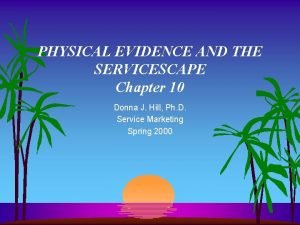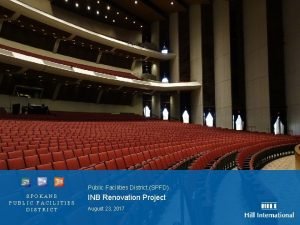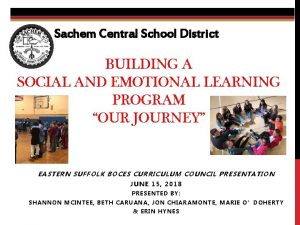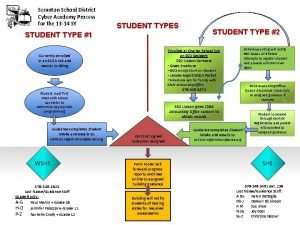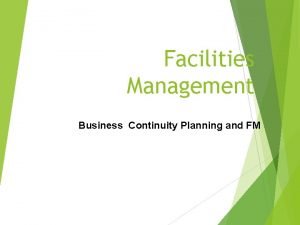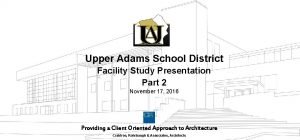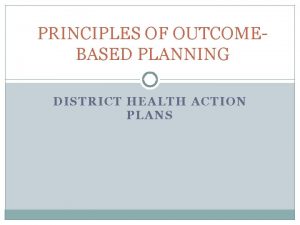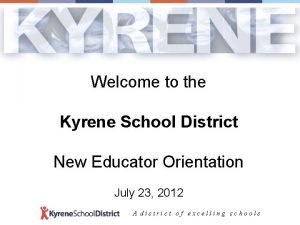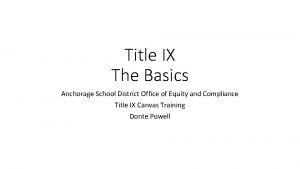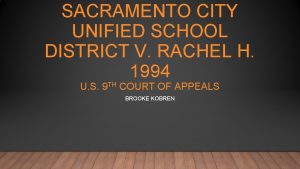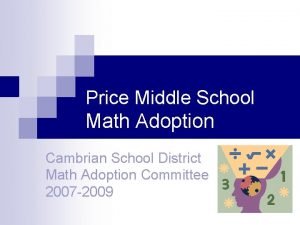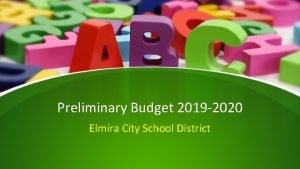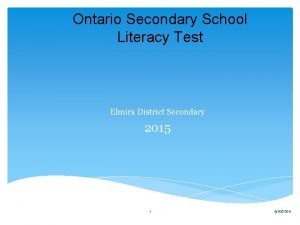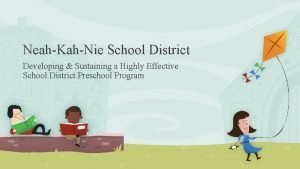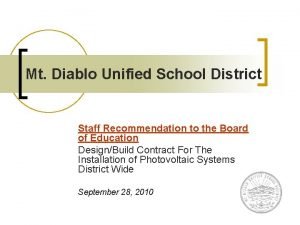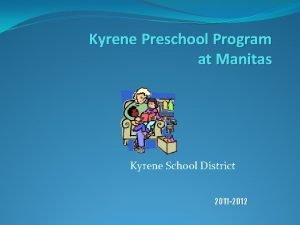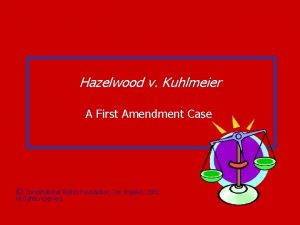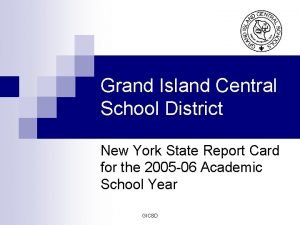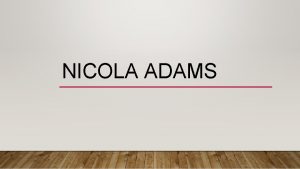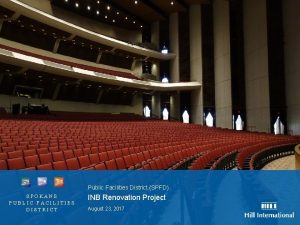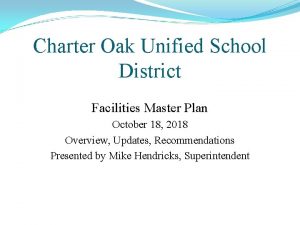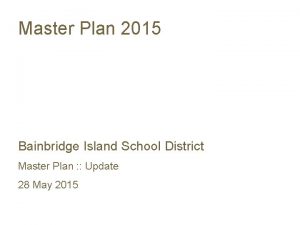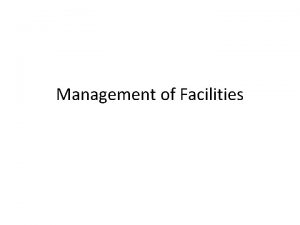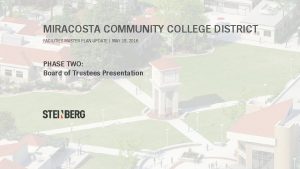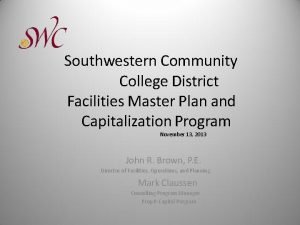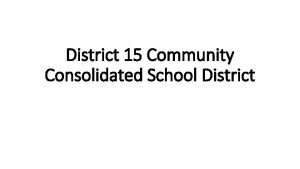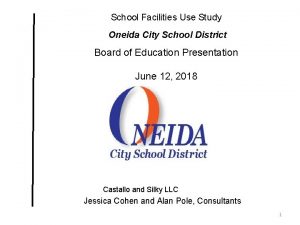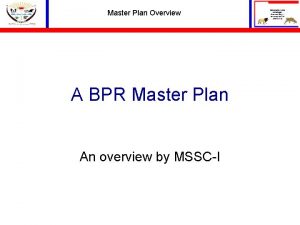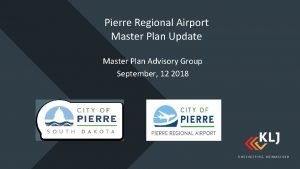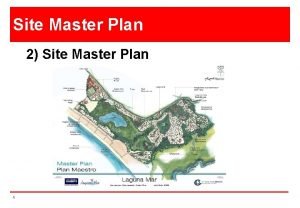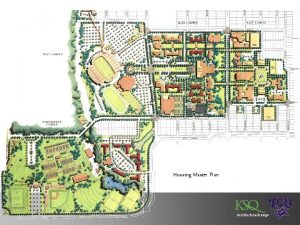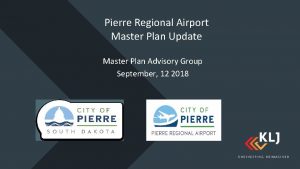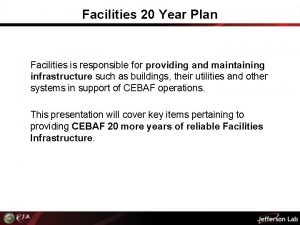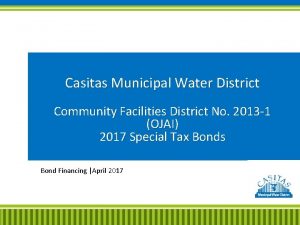Adams 14 School District Facilities Master Plan INTRODUCTION































- Slides: 31

Adams 14 School District Facilities Master Plan

• INTRODUCTION 1 -5 MASTER PLANNING PROCESS 1 -6 VISION ENROLLMENT & CAPACITY FACILTIES 1 -6 SCHOOL DISTRICT STRATEGIC PLAN • EXECUTIVE SUMMARY 1 -7 DEMOGRAPHIC ANALYSIS & ENROLLMENT PATTERNS 1 -13 EDUCATIONAL PLANNING 1 -22 FACILITIES BY SCHOOL EDUCATIONA L PROGRAM 1 -27 COMPREHENSIVE RECOMMENDATIONS • SUPPORTING DOCUMENTS 2 -1 DEMOGRAPHICS 2 -23 EDUCATIONAL PLANNING BY SCHOOL 2 -41 FACILITIES (INDIVIDUAL SCHOOLS) 2 -157 SITE AND CIVIL • APPENDIX 3 -1 DEMOGRAPHICS 3 -10 EDUCATIONAL PLANNING (INDIVIDUAL SCHOOLS) Table of Contents Adams 14 School District Facilities Master Plan 2

Located seven miles north of downtown Denver, Adams 14 serves approximately 7, 000 students and 33, 000 residents in the historic community of Commerce City, Colorado. Student academic success is the number one priority for Adams 14, as a result, we focus our energy and resources on providing quality first time instruction. In addition, Adams 14 is proud to offer opportunities to enhance the lives of our students. From quality music and art programs in every school to 21 st century technology access throughout the District, Adams 14 is committed to providing leading edge learning in its schools. We serve students at: • • • • Alsup Elementary School (Alsup) Central Elementary School (Central) Dupont Elementary School (Dupont) Kemp Elementary School (Kemp) Monaco Elementary School (Monaco) Rose Hill Elementary School (Rose Hill) Hanson Pre. K-8 School (Hanson) Adams City Middle School (ACMS) Kearney Middle School (KMS) Adams City High School (ACHS) Lester Arnold High School (Lester Arnold) Sanville Preschool STARS Early Learning Center (Preschool) Community Leadership Academy (CLA - charter school) Introduction Adams 14 School District Facilities Master Plan Our Students and Staff A state and nationally recognized leader in innovative education, Adams 14 has 464 teachers, 38 administrators and 347 support staff, for a total of 847 full and part-time employees. We are proud to be the second largest employer in Commerce City. Adams 14 is an affirmative action equal opportunity employer. We offer an extensive staff development program, providing employees opportunities for support, growth and renewal. Total Enrollment 6, 702 77% Hispanic 18% Anglo 3% African American 2% American Indian Economic Considerations Adams 14 serves Commerce City, a largely industrial suburb of Denver. The area is comprised almost entirely of low income residents as evidenced by the high percentage of students on the free or reduced lunch program. To their credit, the citizens of the District passed an $84. 6 million bond issue in November of 2006 that funded the construction of the first new building in the district in over 40 years, a state-of-the art replacement High School with a Community College component aimed at keeping potential student drop-outs in school by offering job training at the school. The remainder of the bond money was used to add new Kindergarten classrooms and air conditioning to all of the District’s Elementary Schools. Previously, no elementary school classrooms in the District even came close to meeting the state standards for square footage of 1, 000 SF. 3

Age of Facilities Except for the new replacement High School, all of the District’s schools are reaching their life expectancy. Most were built in the 1950’s. Obviously, buildings of this age suffer from a range of physical deterioration and fail to meet modern code and construction standards. Likewise, the fundamental design of these old buildings fails to meet current teaching needs and methodologies. Given the District’s primary mission to improve student achievement, this shortcoming is no less important than maintaining the buildings’ envelopes and systems. Nearly all of the schools’ physical shortcomings have been addressed to some degree by the District’s maintenance programs over the years, keeping the schools safe and relatively functional for students and staff. As might be expected, physical building repairs have been the focus of most of the improvements, rather than the educational needs. Technology upgrades are the exception to this rule. Other educational shortcomings, like small, inflexible classroom sizes and lack of storage and teacher collaboration space, are more difficult to overcome given the bearing wall construction used for these schools. Introduction Adams 14 School District Facilities Master Plan District Maintenance It is important to note that Adams 14 has maintained and upgraded its schools incrementally over the years. None are in crisis condition; although the roofs of several are caught in an annual cycle of ongoing repairs. Complete replacement is the only reasonable option to end the cycle of rising maintenance expenditures. Roof replacements would include the addition of insulation, which would in turn decrease annual operating costs for heating and cooling these buildings. Planning for the Future The common age of the buildings poses a particular dilemma for future planning because the District must confront the need for replacement of nearly all of its school buildings at the same time. That time is now. However, wholesale replacement over a short time frame is not a realistic financial option. Nor is it a wise one, the District does not want to face this same dilemma 50 to 60 years from now. The question of how to provide modern facilities for all of the District’s students in as equitable a fashion as possible over the next decades is one we will address in the Recommendations portion of this report. For now, suffice it to say that a simple formula of building one replacement school a decade or so, will not suffice. Financial Stewardship The building upgrades have always been undertaken with the intention of good stewardship. The District puts students needs first. Adams 14 is waiting to hear about the status of an American Recovery and Reinvestment Act (ARRA) grant application submitted last year to secure funds for a roof replacement at one of its schools. 4

Master Planning Process The Strategic Facilities Master Plan (SFMP) process was undertaken in the spring of 2010 to continue work begun with the District’s Comprehensive Appraisal for District Improvement (CADI) and as a prerequisite for BEST Grant applications. The SFMP has the long-term goal of projecting the District’s facilities improvements over a tenyear planning horizon, and the short-term goal of being completed in 90 days to meet the BEST Grant application deadline of April 9, 2010. To meet this aggressive schedule, three normally subsequent tasks were tackled concurrently: 1. Demographics/ enrollment analysis and projections 2. Educational Planning – curriculum models translated into educational criteria and plan diagrams 3. Facility condition assessments (built on the Colorado Department of Education (CDE) assessments) The final step of the SFMP, Prioritization and Recommendations, had to be taken sequentially after completion of the first three. Tasks identified: • Project Kick-Off • Educational Program Vision, as it relates to facilities • Educational Facility Standards, as it relates to CDE and the strategic goals and educational vision of the District • Demographic Analysis and Trends • Site Needs Assessment, Facility Conditions and Educational Suitability • Community Engagement • Financial Analysis • Prioritization and Recommendations These tasks were each performed by sub-committees directed by an overall Steering Committee formed by District and Consultant Team members. Introduction Adams 14 School District Facilities Master Plan 5

Inspire: The students are inspired by a belief in a bright future. Educate: Teachers and Parents educate children to be citizens of the world. Empower: Through education, we empower students for success. Adams County School District-14 Strategy Map Vision: School District Strategic Plan Adams 14 School District Facilities Master Plan 6

Student Generation Rates Long-Term Enrollment Forecasts and Facility Requirements Future student populations are projected using the build out of known and potential housing units as provided by Adams County and the Cities of Commerce City and Thornton. The term build out is defined as full construction of Adams 14 Student Generation Rates by Unit all the homes that are platted, subdivided or Type: allowed by a comprehensive plan but are not yet 2004; 2006 & 2009 built. This information is used by Adams 14 for long-term facility capacity and site planning, and 0. 700 in addition helps us determine the types, 0. 600 number and location of schools needed. 0. 500 As shown in Table 4, students who reside in 0. 400 mobile homes and multifamily units have 0. 300 increased considerably in recent years, while 0. 200 there is relatively little change in both multi 0. 100 family and single family type units. The term student generation rate used in Table 4 means Mobile Home Multi-family Single the number of students generated from the Family various types of housing. The historic data from Attached Detached our consultants, Strategic Resources West (SRW), indicates that other Denver Metro Area schools and other Front Range Communities 2004 2006 2009 have higher student generation rates in single family units, but lower student generation rates in mobile home and multifamily units. The “spike” in 2009 student generation rates in mobile home and multi-family units is believed to be a reflection of the State’s and Metro area’s weak economy and the greater affordability of these types of housing units: Adams 14 School District Facilities Master Plan 7

Table 4. Adams 14 Historical and Recommended Planning Yields 2009 Unit Type Mobile Home Multifamily Single Family Attached Single Family Detached Student Generation Rates: 2009 Elementary Middle Senior High Total 0. 334 0. 122 0. 155 0. 610 0. 324 0. 108 0. 119 0. 552 0. 307 0. 116 0. 127 0. 550 0. 295 0. 126 0. 160 0. 580 2006 Unit Type Mobile Home Multifamily Single Family Attached Single Family Detached Student Generation Rates: 2006 Elementary Middle Senior High Total 0. 274 0. 106 0. 090 0. 471 0. 168 0. 062 0. 060 0. 290 0. 308 0. 107 0. 129 0. 544 0. 291 0. 130 0. 152 0. 573 2004 Unit Type Mobile Home Multifamily Single Family Attached Single Family Detached Student Generation Rates: 2004 Elementary Middle Senior High Total 0. 226 0. 102 0. 071 0. 399 0. 197 0. 064 0. 325 0. 271 0. 137 0. 115 0. 523 0. 291 0. 136 0. 147 0. 573 Weighted Average Unit Type Mobile Home Multifamily Single Family Attached Single Family Detached Student Generation Rates: Weighted Average Elementary Middle Senior High Total 0. 278 0. 110 0. 105 0. 493 0. 230 0. 078 0. 081 0. 389 0. 296 0. 119 0. 124 0. 539 0. 292 0. 130 0. 153 0. 575 Recommended Student Generation Rates: SRW Recommended Unit Type Elementary Middle Senior High Total Mobile Home 0. 275 0. 110 0. 115 0. 500 Multifamily 0. 200 0. 080 0. 070 0. 350 Single Family Attached 0. 300 0. 120 0. 540 Single Family Detached 0. 295 0. 130 0. 155 0. 580 Note: Student generation rates exclude preschool students. Adams 14 School District Facilities Master Plan Births within Adams 14 have increased in recent years in both absolute terms and our proportionate share of total births within Adams County. Consequently, more children are residing within Adams 14’s boundaries and accordingly our student enrollments should go up. Even so, it is SRW’s opinion that student generation rates for lower priced housing units tend to be inversely related to economic conditions. Thus, as the economy improves, student generation rates will likely decline from the 2009 level and more closely approximate the suggested planning rates. Thus, according to the City’s new Comprehensive Plan, housing stock within the District could increase by nearly 2, 100 homes or about 19 percent from the existing number of units. This would require removing existing housing from selected areas of the District, primarily in the Rose Hill Elementary School area south of 56 th Avenue and east of Kearney Street (see Figure 1). As mentioned earlier, future housing potential within Adams 14 is scattered and is, for the most part, limited to individual lots. In fact, the Comprehensive Plan recently approved by Commerce City would further diminish that potential by more than 500 homes. (1) 8

Figure 1 Future Housing Units by: Existing New Housing Comp. Change in: . Unit Type Units Zoning Plan Units Percent Mobile Home 1, 634 75 - 0. 0% Multifamily 1, 080 461 183 (278) -60. 3% Single Family Att. 1, 099 447 442 (5) -1. 1% Single Family Det. 7, 143 1, 659 1, 390 (269) Total 10, 956 2, 642 2, 090 (552) -16. 2% -20. 9% Based upon the above housing potential and student generation rates, Adams 14 could add another 1, 150 Kindergarten through 12 th grade students over and above the long-term expectation from existing housing (see Table 5). If that is true, our student population would be about 7, 510 students. From those 7, 500 students, more than 3, 800 would be in the elementary grades (K - 5), about 1, 650 would be in the middle school grades (6 – 8) and about 2, 030 would be in high school (grades 9 – 12). Implications follow regarding school capacities and planning for future facilities. Adams 14 School District Facilities Master Plan 9

Table 5. Adams County School District 14 Long-Term Student Potential Unit Type Mobile Home Multifamily Single Family – Att. Single Family – Det. Total In District Oct. 2009 Actual Long-Term Estimated Students from Existing Housing* Elementar Senior Total w/ y Middle High Total PK 449 180 188 817 891 216 86 76 378 427 330 132 593 643 2, 107 929 1, 107 4, 143 4, 536 3, 102 1, 327 1, 503 5, 931 6, 496 3, 336 1, 340 1, 665 6, 341 6, 939 Out of District^ 126 68 238 455 478 ^: Held at 2009 level. Grand Total 3, 228 1, 395 1, 741 6, 386 6, 974 *: Based upon recommended student generation rates. Unit Type Mobile Home Multifamily Single Family – Att. Single Family – Det. Total In District Potential Additional Students from Future Housing Elementar Senior Total w/ y Middle High Total PK 21 8 9 38 41 37 15 13 64 72 133 53 239 259 410 181 215 806 883 600 257 290 1, 146 1, 254 Unit Type Mobile Home Multifamily Single Family – Att. Single Family – Det. Total In District Total Future Students by Housing Type Elementar Senior Total w/ y Middle High Total PK 470 188 197 855 931 253 101 88 442 499 462 185 832 901 2, 517 1, 109 1, 323 4, 949 5, 418 3, 702 1, 583 1, 792 7, 078 7, 750 Out of District 126 68 238 432 478 Grand Total 3, 828 1, 651 2, 030 7, 510 8, 228 Adams 14 School District Facilities Master Plan Future Facility Needs The above student expectations are also broken down by elementary school attendance area to assist with planning school capacity needs. This approach suggests that longterm capacity requirements will be higher than current permanent facility capacity and varies by school attendance area. (See Table 6. ) Again, the homes that would generate the additional future students will likely build very slowly since most new construction would be on infill lots. The majority of future homes to be built would be in the Alsup attendance area north and west of the South Platte River. Although these units could generate quite a few students, the closer proximity of schools in other districts suggests that many of these students may enroll out of district and not attend Alsup, Adams City Middle School or Adams City High School. Thus, it will be prudent to monitor housing construction and enrollment over time to gauge how many students will be realized from this area. Feeder system capacity balance. Adams 14 schools have a wide range of capacities within each school level; a characteristic that may result in less efficient ways to house students. For example, when families move into an area, many parents want to know which schools their children will attend. Furthermore, many parents would prefer that their children progress through the grades with their friends and that they not be separated when they continue to the next school level, e. g. from elementary to middle school. Using the schools below, this situation would likely result in an imbalance of enrollment capacity for each school type, thus creating the need to split attendance boundaries as students graduate to the next school level, or resulting in either inefficient use of a building or overcrowding. 10

Table 6. Adams County School District 14 Long-Term Enrollment and Capacity Comparison School Type Permanent Facility Enrollment: Schools Student Capacity Schools to Fill per Smalle Capacity * Grade st Largest Excess Capacity (Enrollment) Elementary: Kemp ES (smallest K Build Out 5) 306 51 Central ES (largest K (3405) 460 77 ) Middle: (95 NA NA Fall 2009 Build Out Capacity Fall 2009 Alsup 559 799 459 (100) Central 579 555 460 (119) CLA 341 NA 333 (8) Dupont 540 736 397 (143) Hanson 338 181 Kemp 370 508 Monaco 435 478 Rose Hill 394 444 276 (62) 95 (202 Table 6 shows that Kemp Elementary School has the Senior High (ACHS) 1, 523 381 1. 97 1. 92 306 (64) ) smallest capacity of any elementary school and Central (123 *: Rounded to nearest five. 355 (80) ) Elementary School has the largest capacity. Kemp has (29 415 21 space for about 305 students in Kindergarten through sixth ) (1, 03 grade or about 51 students per grade. Central’s capacity is 3, 001 (555) 3) Elementary Schools: Total Elementary 3, 556 3, 701 180 (23) Hanson 143 77 Kearney MS 525 650 NA 1, 490 1, 583 Senior High Schools: Lester Arnold HS NA (89 Adams 14 School District Facilities Master Plan 1, 868 1, 792 1, 703 (165) ) Total Sr. High 580 193 3. 79 2. 52 203 131 Adams City HS 595 198 3. 89 2. 59 1, 665 1, 792 691 856 CLA Total Middle Adams City MS NA (339 Kearney MS ) about 460 students or 77 students per grade. Adams City and Kearney Middle Schools have nearly the same total capacity so there is little difference in the capacity per grade. (261 If all elementary schools were built to the same capacity as 595 (96) ) Kemp it would take 3. 89 elementary schools to fill Adams City 167 36 NA MS. In comparison, it would only take 2. 59 elementary 173 30 96 schools if they had the capacity of Central. From an (70 580 55 efficiency perspective, it is apparent that such imbalances can ) (235 cause scheduling difficulties and inefficient or more costly 1, 515 25 ) operating expenses. This capacity differential increases the potential of uneven student distribution among the schools, and thus, increases the potential of underutilized or over (269 utilized facilities. 1, 523 (142) ) Middle Schools: Adams City MS ) 11

The data suggests that about 1. 90 middle schools are required to fill ACHS to its capacity of 1, 500 students. However, total middle school capacity approximates 1, 175 students or 391 students per grade (excludes CLA and Hanson), which is greater than the 375 students per grade capacity at Adams City HS. We believe that potential overcrowding can be eliminated or diminished because some students will enroll at Lester Arnold High School, and regrettably, if history is an accurate indication of the future, student attrition will lessen our high school population, particularly in the upper grades. The effects of Hanson and the charter school are not shown; the above narrative has been provided to illustrate the cause and effect of various factors on student enrollment. This type of analysis is essential in Adams 14’s long term planning process. Strategic Resources West believes that Adams 14 would benefit from a comprehensive facility capacity planning system. Such a review could lead to more efficient use of facilities as well as greater patron satisfaction. Preparing a comprehensive educational specification for each school level and then aligning the capacities could accomplish this goal. Adams 14 Facilities Master Plan Adams 14 School District Facilities Master Plan Summary and Recommendations Enrollment at all three school levels is expected to exceed facility capacity over the next few years. However, interim capacity enhancement measures, such as continued use of modular classrooms, may be a cost-effective strategy for the near term. It is suggested that the District prepare for future enrollment expectations by developing a strategy for accommodating enrollment that includes both interim and longterm solutions that are acceptable to its community. It is strongly recommended that the District study its desired school sizes by level and develop educational specifications that will guide facility capacity and school site location planning in the future. A second recommended step is to identify gaps in facility locations, e. g. in the northwest, to determine if a potential school site(s) central to that student population might make economic sense. 12

The Educational Planning process comprised the following three phases: • • • Visioning and goal setting Facility evaluation with respect to educational program delivery Recommendations through educational design criteria The recommendations contain graphic and verbal descriptions of spaces and their relationships to adjacent spaces. The purpose of these diagrams is to understand the necessary proximity, prototypical arrangement, and components that make up a specific group of spaces that would be found together. In developing these recommendations, the intent is to create a diagram which can be “overlaid” on the existing buildings to determine what pieces are missing from the ideal program model. With this process, consideration is given to logical displacement of programs occurring in existing spaces that could be moved to create the ideal program model. In many instances, such as classroom size, existing classrooms at 800 SF would be increased to 900 SF to meet the ideal model classroom size. For this reason, it is crucial to replace the core instructional spaces. In planning the replacement instructional spaces, these recommendations could be used to suggest total areas that would provide the educational environment determined ideal for the Adams 14 School District. In the recommendations, the components of each type of facility, Elementary and Middle, are discussed individually and square footage areas are described for each component. At the end of each model, the total summary and grossing factor areas (additional areas required for corridors, toilet rooms, mechanical and janitor closets, etc. ) can be found. It is important to note that in the Recommendations, optimal classroom size is addressed. Under the school program descriptions, the typical components and programs housed in these classrooms and the rationale used to come to these conclusions are described. These ideal class sizes are based on recommended CDE standards, and it is the recommendation of the Educational Planning Committee to attempt to comply as closely as possible with these standards. The inclusion of this information and its impact on demographic projections is described in the demographic section. Application of the educational design criteria was evaluated on the ability to reasonably achieve the educational model goals in any given existing facility. Some facilities, due to restrictive site areas or limiting adjacency issues, were considered on an individual basis and the intent of the program was incorporated to the extent possible. Executive Summary: Educational Planning Adams 14 School District Facilities Master Plan 13

“To improve student achievement so that 80% of students assessed will be on grade level by 2014 by ensuring that each classroom has a dynamic, standards-based teacher who provides powerful 21 st century learning experiences to all students”. Adams County School District-14 Strategic Plan. Nov 2008. Empowering Collaborative Teachers Environments Neighborhood Schools Goal 1: Empowering Teachers Intent: Provide structured support to enable teachers to be a dynamic, standards-based presence in the classroom. • • • Dynamic instructional practices Expect greatness from the teachers and students Standard based teaching practices and outcomes Clarity in expectations Align daily lessons to the curriculum Engage students constantly Facility Impact: • Adaptability/flexibility • Classroom design • Teacher “Neighborhoods” • Project-based teaching • Storage /display Executive Summary: Educational Planning Goals Adams 14 School District Facilities Master Plan 14

Goal 2: Collaborative Environments Goal 3: Neighborhood Schools Intent: Facility has to reflect the vision of student-centered teaching, active learning, and cooperative groups through effectively engaging students and creating energy, action motivation. • and. Teacher collaboration • Student collaboration • SPED collaboration • Inviting environments that support creativity, expression and demonstration • Learning and interaction beyond the classroom walls – pods, teaming centers, alcoves Intent: Providing structures that encourage schoolcommunity connections. • Welcoming architecture • Safety and security • Early education consolidation (with SPED component) • Respect pride in neighborhood schools, especially at the middle schools Facility Impact: • Classroom design • Specialized spaces • Library Media Center (LMC) • Instructional technology (IT) and communication • Inviting environments • Equipment and furniture • Storage/display • Student engagement Facility Impact: • School size • Safety and security • Student engagement • Traffic/entrances/exits • Parents/community • Curb appeal • Early Childhood Center Executive Summary: Educational Planning Goals Adams 14 School District Facilities Master Plan 15

Educational Design Criteria The purpose of the educational design criteria is to provide Adams 14 with a tool that defines educational concepts, in order to inform future building design. During the Master Planning process, the educational design criteria were developed for elementary and middle schools. Key features for high schools were also discussed, the focus for which was evaluating the new high school from an educational delivery standpoint. These design criteria were developed by the Educational Planning Committee through a series of worksessions. The primary focus of these committees was that curriculum should drive the development of the design criteria. The committee also addressed the impact of community needs and developed criteria that reflects the unique identity and culture of the community and its educational vision. During this process, definition of critical factors such as growth impact, changes occurring in current facilities, and the following list of items were addressed: • Philosophy and objectives of the School District • Services to students, teachers and the community • Organization of schools and core instructional spaces • Methods of instruction • Program of studies • Desired environment (interior and exterior) • Utilization of space Executive Summary: Educational Planning Adams 14 School District Facilities Master Plan 16

Elementary Core Instructional THREE (3) ROUNDS : 450 STUDENTS The diagrams are not intended to be building plans, but a guide for developing those plans. They suggest configurations and adjacencies that support the educational design criteria. K FOUR (4) ROUNDS : 600 STUDENTS PS K K 1 1 3 2 3 2 1 1 PS PS TN SPED 1 TN 5 SPED CONNECTION TO SHARED INSTRUCTIONAL & COMMON AREAS 5 4 4 4 ONE (1) ROUND: 150 STUDENTS 6 TEACHING STATIONS 1 TEACHER NEIGHBORHOOD 1 PRESCHOOL (OPTIONAL) 9 Classroom Pairs @ 2, 100 SF 18, 900 SF 2 Preschool @ 1, 000 SF 2 Teacher Neighborhood 2, 850 SF 2 SPED Classroom 1, 200 SF PROGRAM AREA 24, 950 SF K K 2 2 TN 3 3 TN 5 PS K K SPED 2 2 SPED 3 3 5 5 5 1 4 4 CONNECTION TO SHARED INSTRUCTIONAL & COMMON AREAS 12 Classrooms Pairs @ 2, 100 SF 25, 200 SF 2 Preschool @ 1, 000 SF 2 Teacher Neighborhood 2, 850 SF 2 SPED Classroom 1, 200 SF PROGRAM AREA 31, 250 SF Executive Summary: Educational Design Criteria Adams 14 School District Facilities Master Plan 1 17

Middle School Core Instructional The diagrams are not intended to be building plans, but a guide for developing those plans. They suggest configurations and adjacencies that support the educational design criteria. CR CLUSTER (by Grade Level): 140 STUDENTS (@25 -28 Students/CR) SCIENCE CR CR TUTORING COLLABORATION TOILETS/ ZONE SUPPORT CR Grade 7 Grade 6 TN TN Grade 8 CONNECTION TO SHARED INSTRUCTIONAL & COMMON AREAS 4 CLASSROOMS @ 1, 000 SF 4, 000 SF 2 TUTORING SPACES @ 75 SF 150 SF 1 SCIENCE CLASSROOM 1, 200 SF 1 SCIENCE PREP 300 SF 1 SCIENCE STORAGE 200 SF 1 COLLABORATION ZONE 900 SF SUPPORT SPACES 650 SF TOTAL 7, 400 SF Grade 7 TWO (2) CLUSTER PER GRADE LVL: NO. OF STUDENTS 750 -840 Students CLUSTER AREA 44, 400 SF TEACHER N’HOOD 5, 700 SF TOTAL 50, 100 SF Executive Summary: Educational Design Criteria Adams 14 School District Facilities Master Plan 18

Elementary Middle Classroom 900 -1, 000 SF Classroom “Pair” 2, 100 – 2, 500 SF -- Teacher Neighborhood 1, 425 SF 2, 850 SF Core Instructional Elementary Program Area Building Area (P. A. x 1. 25) 2 Rounds - 300 Students 15, 625 SF 19, 532 SF 3 Rounds - 450 Students 24, 950 SF 31, 188 SF 4 Rounds – 600 Students 31, 250 SF 39, 063 SF CORE UNITS OPTION 1: CORE INSTRUCTIONAL AREA REPLACEMENT Core Instructional Middle 2 Clusters per Grade Level 50, 100 SF 62, 625 SF (6 Clusters = 840 Students) Executive Summary: Educational Design Criteria Adams 14 School District Facilities Master Plan 19

450 Students 600 Students 24, 950 SF 31, 250 SF Library Media Center 4, 120 SF 4, 520 SF Art Room 1, 200 SF Music Room 1, 200 SF SPED Suite 2, 400 SF Physical Education 3, 950 SF Administration 2, 660 SF Cafeteria (w Performance Platform) 3, 350 SF 4, 100 SF Kitchen 1, 200 SF 1, 400 SF Building Support 2, 150 SF 2, 750 SF PROGRAM AREA 47, 180 SF 55, 430 SF BUILDING TOTAL (P. A. x 1. 25) 58, 975 SF 69, 288 SF Core Instructional Area Classrooms Teacher Neighborhoods CORE INSTRUCTION OPTION 2: REPLACEMENT SCHOOLS (Area Summary Option 2: ELEMENTARY SCHOOL) Shared Instructional Area Support (Non Instructional) Areas Executive Summary: Educational Design Criteria Adams 14 School District Facilities Master Plan 20

750 -840 Students Core Instructional Area 50, 100 SF Classrooms Teacher Neighborhoods CORE INSTRUCTION OPTION 2: REPLACEMENT SCHOOLS (Area Summary Option 2: MIDDLE SCOOL) Shared Instructional Area Library Media Center 7, 200 SF “Exploratory” Learning Areas 13, 600 SF Art, Music, Media--Tech, Business-Career SPED Suite 4, 500 SF Physical Education 18, 600 SF Support (Non Instructional) Areas Administration Counseling 3, 800 SF 775 SF Commons (with Perf. Platform, Kitchen) 10, 100 SF Building Support 2, 750 SF PROGRAM AREA 111, 425 SF BUILDING TOTAL (P. A. x 1. 25) 139, 281 SF Seats 300 Executive Summary: Educational Design Criteria Adams 14 School District Facilities Master Plan 21

Facilities The fundamental and critical problem facing the District is the fact that most (10 out of 12) of their schools were originally built 50 years or more ago. The common life expectancy of buildings from the decade of the 1950’s is 50 - 60 years. These two facts suggest that the substantial renovation or replacement of nearly all of the District’s schools is imminent. Our examination of the schools and the CDE assessments largely support this conclusion. While Adams 14 has done a commendable job maintaining these facilities over the years, the District’s limited funding and rapidly growing maintenance needs (due to the common age of its facilities) have combined to create a looming crisis. Unlike many districts, Adams 14 has continued to set aside an annual maintenance fund for capital repairs even though state law no longer requires it. Adams 14 annually sets aside significant funds for its capital reserve fund to keep these aging buildings safe and operational for their students and staff. Executive Summary: Facilities Adams 14 School District Facilities Master Plan In November 2006, the community passed a bond issue that funded the construction of a replacement facility for the District’s only comprehensive high school – Adams City High School. In an effort to stem its rather high drop-out rate, the District partnered with local community colleges and businesses to include space in the new school for entry -level college programs. Adams City High also has a school-based health clinic in the building. The District’s only other high school is Lester Arnold Alternative High serving drop-outs and other students re-entering school. The District and community did not limit the scope of the bond money to the new high school. They apportioned some of the bond money to each of the elementary schools for new full-day Kindergarten classrooms and another portion to the middle school for science room upgrades. In addition, air conditioning was added to all of the schools. These improvements often required electrical system upgrades and enabled basic safety improvements, like new fire access roads. It had been 10 years (1996) since this economically disadvantaged community had passed a school bond issue and the District responded with wise and equitable use of the funds granted, spreading the benefit throughout the District. But the District has not stopped there. It has executed a performance contract with Siemens for upgraded irrigation systems, thermal solar, HVAC controls, IGV-VFD conversion, lighting and plumbing for all of its older schools. Furthermore, the District has applied for an AARA grant for replacement of Kearney Middle School’s roof – one of the worst in the District. This is the story of a district searching every avenue for ways to serve its students and community. 22

This spring Adams 14 completed a community survey to gauge the viability of a mill levy increase to fund rising operational expenses and a school bond issue to fund capital improvements. The results showed support for the mill levy, but not for the school bond issue. The largest facility concern is the deteriorating condition of school roofs across the District. Numerous annual repairs and quick patch jobs have minimized substantial damage. Nonetheless, the increasing frequency and extent of repairs clearly indicate that full replacement is a better use of funds than the endless cycle of patching. Yet, the District chose to aim higher than comprehensive roof replacements for the 2006 school bond issue. Providing new and well-conditioned learning environments were, and are, seen as trumping roof replacements for two main reasons. First, the new classroom space and air conditioning have a more direct effect on student achievement than new roofs would. Second, the District can continue to repair the old roofs with capital reserve funds for a while longer. However, the amount of those funds would not begin to address the shortage of classroom space or the addition of air conditioning, which makes the classrooms more bearable in warm weather and removes a major distraction from student learning. Executive Summary: Facilities Adams 14 School District Facilities Master Plan Along with the physical deterioration of 50+ year-old buildings, there are parallel instructional shortcomings incumbent with buildings of this era. Over 75% of the elementary school classrooms are under the acceptable square footage for classrooms with 25 students (25 x 35 = 825 SF). Most are above the 600 SF CDE minimum square foot requirement, but class sizes would need to average 20 -21 students for most of these classrooms to meet the SF/student guideline. Our master planning work with the District Educational Planners came back to this classroom size issue repeatedly as an obstacle to implementing modern instructional methods. Enlarging nearly every elementary school classroom in the District is a daunting challenge in itself. Further complicating the situation is the fact that all of the school buildings are masonry bearing wall construction – making incremental expansions completely impractical. Likewise, removing a dividing wall between two classrooms would usually yield more than the needed square footage and a room proportion unfavorable for teaching (well off CDE’s guideline of 1: 1. 3). This approach would require internal columns or other substantial structural alterations, as well. Another common and crucial instructional shortcoming is the lack of teacher collaboration space in the buildings. The Educational Planning Subcommittee sees the addition of collaboration space as indispensible for the implementation of their instructional improvements plan. Since the convenient location of such a space is essential to its use, the bearing wall construction of the schools again poses a serious limitation on its implementation. 23

ISSUES 4. The District needs to make a decision regarding the disposition of the old Adams City High School (ACHS) property. After long deliberation, we believe Adams 14 should sell the property for the following primary reasons – 5. the same ones that led to the decision to seek a new site for the new ACHS a few years ago. 1. 2. 3. Substantial renovation of the building would have to include the high cost of hazardous materials abatement and demolition. Some of the athletic facilities on the site have beneficial use to other members of the community. For instance, the District is currently renting the use of the football stadium to a local soccer club. The location directly adjacent to the busy Highway 85 6. The potential to improve the community and team is not a safe one for a school. The site is mostly with a commercial or institutional partner, if the right adjacent to commercial and industrial uses that buyer and use can be found. generate, and benefit from, the high traffic volumes and easy vehicular access. The District and the master planning team have considered an overall facilities approach of ongoing The existing building, originally constructed in 1939 remodels, renovations and incremental additions to its old (with classroom addition in 1952 and cafeteria and school buildings and sites. This would respond directly to field house with gym and pool addition in 1960) is in the community’s common preference for equitable poor condition and is further deteriorating since the distribution of school improvements. Nonetheless, we District decommissioned it and moved into the new have concluded that new, or substantially new, buildings Adams City High School (ACHS) in the fall of 2009. are needed for the following reasons. The building organization with several additions and remodels is not well-suited for any modern educational use without substantial remodeling and building envelope and systems upgrades. 1. The 50 -60 year-old masonry bearing-wall construction buildings, while sound structurally, are difficult and expensive to renovate. One example – failing plumbing located inside the masonry walls is impossible to replace without substantial and costly demolition and repair of the walls. Subsequently, most piping replacements have taken the approach of abandoning the old pipe in the walls and installing the new piping on the face of the interior walls. Executive Summary: Facilities Adams 14 School District Facilities Master Plan 24

2. 3. The impracticality of enlarging the mostly undersized classrooms (95% of the elementary and 61% of the MS) again due to the masonry bearing wall construction. The conviction that the flexibility to accommodate new teaching methodologies can only be achieved by larger classrooms and less restrictive arrangements than are offered by the current narrow double-loaded corridors. New roof tied into existing New wall & foundation Making two [2] Classrooms into one larger room does not comply with CDE (State) length-to-width ratio. Masonry walls make incremental expansion fiscally inefficient Executive Summary: Facilities Adams 14 School District Facilities Master Plan 25

Due to the age of the school facilities, all have the following common problems: Roofs have exceeded their lifespan and are in deteriorated condition. The District incurs constant costs for repairs after any rain or snowstorm. They have incurred damaged ceilings, flooring, ductwork, casework, lesson plans, documents, etc. Recommendation: Full roof replacements with a modified bitumen roof material allowing maintenance by District personnel, along with added roof insulation for better energy conservation. Roof fascias, roof overhang soffits, gutters and downspouts all need varying percentages of maintenance, repairs and or replacement. Recommendation: Replacement or maintenance of components in satisfactory condition to include cleaning and painting. Full replacement of all components would likely need to occur with full roof replacements. Fascias would have to modify to accommodate the additional insulation thickness. Interior carpet finishes are mostly worn, dirty and deteriorating. Vinyl composition tile floors are overall in better maintained condition. Areas were observed where the VCT was in need of striping and waxing. Recommendation: Replacement with a good commercial grade carpet. Some schools have asbestos tile encapsulated under numerous layers of carpet. Ideally all layers would be removed and asbestos tile abated. Classroom cabinetry and countertops are typically part of the original building construction, showing the 50+ year age. Some original porcelain sinks exist along with some replacement stainless steel sinks that are typically in deteriorated condition. Many classrooms have drinking fountain bubblers mounted adjacent to sinks. These drinking fountain bubblers in the classrooms are not standard practice today and are not allowed in classrooms used for Art and Science per Colorado State Regulations for Schools. Recommendation: Replacement of base and upper cabinets and countertops along with tall teacher storage cabinets with plastic laminate faced cabinets and countertops. New stainless steel sinks, faucets and deletion of the drinking fountain bubblers. Poor storm water drainage exists at numerous locations around all of the school facilities. Recommendation: Along with the gutter and downspout maintenance some redirection of storm water away from entries, exits and pedestrian paths should be done. This could include some re-grading, repaving and installing some trench drains to direct storm water away from the buildings. Refer to the Facilities Site evaluations in this document. Executive Summary: Facilities Adams 14 School District Facilities Master Plan 26

Master Plan Recommendation 1. Replace Kearney MS on its current site with a new 800 student facility. (Design and construct new building, demo existing building then re-build displaced fields, parking etc. ). 2. Turn Hanson back into a Pre. K-5 program and move Hanson’s 6 -8 grades into new Kearney and backfill vacated space in Hanson with students from Alsup. 3. Build a new replacement school for ACMS to accommodate 750 -800 students. (Design and construct new building, demo existing building then re-build displaced fields, parking etc. ). 4. Build a new replacement school for Monaco to accommodate 500 students to feed ACMS. (Design and construct new building, demo existing building then re-build displaced fields, parking etc. ). 5. Replace remaining elementary schools in this manner based on priorities for facility condition and community equality. 6. Since Hanson is newest of the elementary schools, convert or replace as a district-wide Preschool facility. Additional Considerations: ACHS site and undeveloped property to help provide funding. Pros: • Meets future enrollment projections • Meets modern education requirements • Replaces aging buildings • Takes one of the worst facilities in terms of maintenance and repairs off the table and reduces the number of aging facilities vying for limited repair funds. Cons: • Replaces only one school at a time when nearly all schools are deteriorating – the rest of the schools cannot afford to wait for their turn. The following charts show the existing District feeder system and its transition to the future “ideal” system. 7. At District Service Center, provide for additional staff parking and space for bus driving skills training in place of existing softball field. Executive Summary: Facilities Adams 14 School District Facilities Master Plan 27

Executive Summary: Existing Feeder System Adams 14 School District Facilities Master Plan 28

Executive Summary: Transitional Feeder System Adams 14 School District Facilities Master Plan 29

Executive Summary: Future “Ideal” Feeder System Adams 14 School District Facilities Master Plan 30

Adams 14 School District Facilities Master Plan 31
 Adams and adams secretarial training
Adams and adams secretarial training Physical layout of nursing unit
Physical layout of nursing unit West kowloon cultural district master plan
West kowloon cultural district master plan Spokane public facilities district
Spokane public facilities district Erin hynes sachem
Erin hynes sachem Lodi unified summer school
Lodi unified summer school Indian school, al wadi al kabir colors
Indian school, al wadi al kabir colors Scranton school district cyber school
Scranton school district cyber school Bussiness continuity plan
Bussiness continuity plan Who is homer
Who is homer Arendtsville elementary
Arendtsville elementary Centergize
Centergize Outcome based planning definition
Outcome based planning definition Ivisions kyrene
Ivisions kyrene Anchorage school district office
Anchorage school district office Skyward family access south kitsap
Skyward family access south kitsap Cherry hill school district+sfra
Cherry hill school district+sfra Sacramento city unified school district v. rachel h
Sacramento city unified school district v. rachel h Puyallup schoology
Puyallup schoology Cambrian school district
Cambrian school district Elmira city school calendar 2020-2021
Elmira city school calendar 2020-2021 Southampton township school district
Southampton township school district Elmira district secondary school
Elmira district secondary school Neahkahnie school district
Neahkahnie school district Mt diablo unified school district
Mt diablo unified school district Cesar chavez high school phoenix
Cesar chavez high school phoenix Kyrene school district preschool
Kyrene school district preschool Abc unified school district
Abc unified school district Hazelwood v kuhlmeier amendment
Hazelwood v kuhlmeier amendment Cathy kuhlmeier
Cathy kuhlmeier Gradebook granite
Gradebook granite Language arts
Language arts

